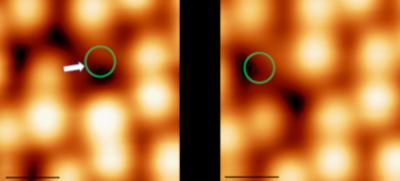Researchers at Japan's OIST, in collaboration with the University of Pittsburgh in the U.S., have characterized the structural defects that prompt the movement of ions, destabilizing perovskite materials. The researchers' findings may help optimize perovskite solar cells.
 This image of a perovskite surface shows the shifting of ions across the surface, and the vacancies causing these movements. Image by OIST
This image of a perovskite surface shows the shifting of ions across the surface, and the vacancies causing these movements. Image by OIST
"For a long time, scientists have known structural defects exist, but didn't understand their precise chemical nature," said Collin Stecker, an OIST Ph.D. student and the first author of the study. "Our study delves into fundamental characteristics of perovskite materials to help device engineers further improve them."
Upon analyzing these images, Stecker and his colleagues noticed groups of vacant spaces across the surfaces where atoms were missing. In addition, they saw that pairs of Br- (bromide) ions on the perovskite surfaces were shifting and changing direction. The OIST researchers' collaborators at the University of Pittsburgh performed a series of theoretical calculations to model the pathways these ions took, supporting these experimental observations.
The OIST scientists concluded that the surface vacancies were likely causing these ions to move across the perovskite materials. Understanding this mechanism of ion movement may later help scientists and engineers mitigate the structural and functional consequences of these defects.
The researchers acknowledged that, although perovskites are promising alternatives to the widely used silicon, the technology needs to be refined before it's commercialized. "These perovskite surfaces are much more dynamic than we previously anticipated," said Stecker. "Now, with these new findings, we hope engineers can better account for the effect of defects and their motion in order to improve devices."